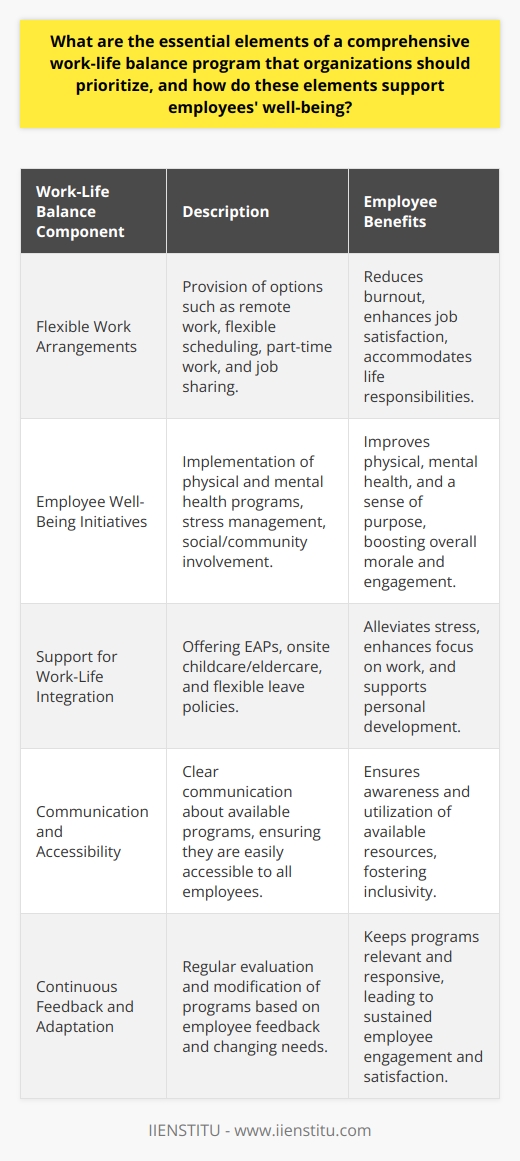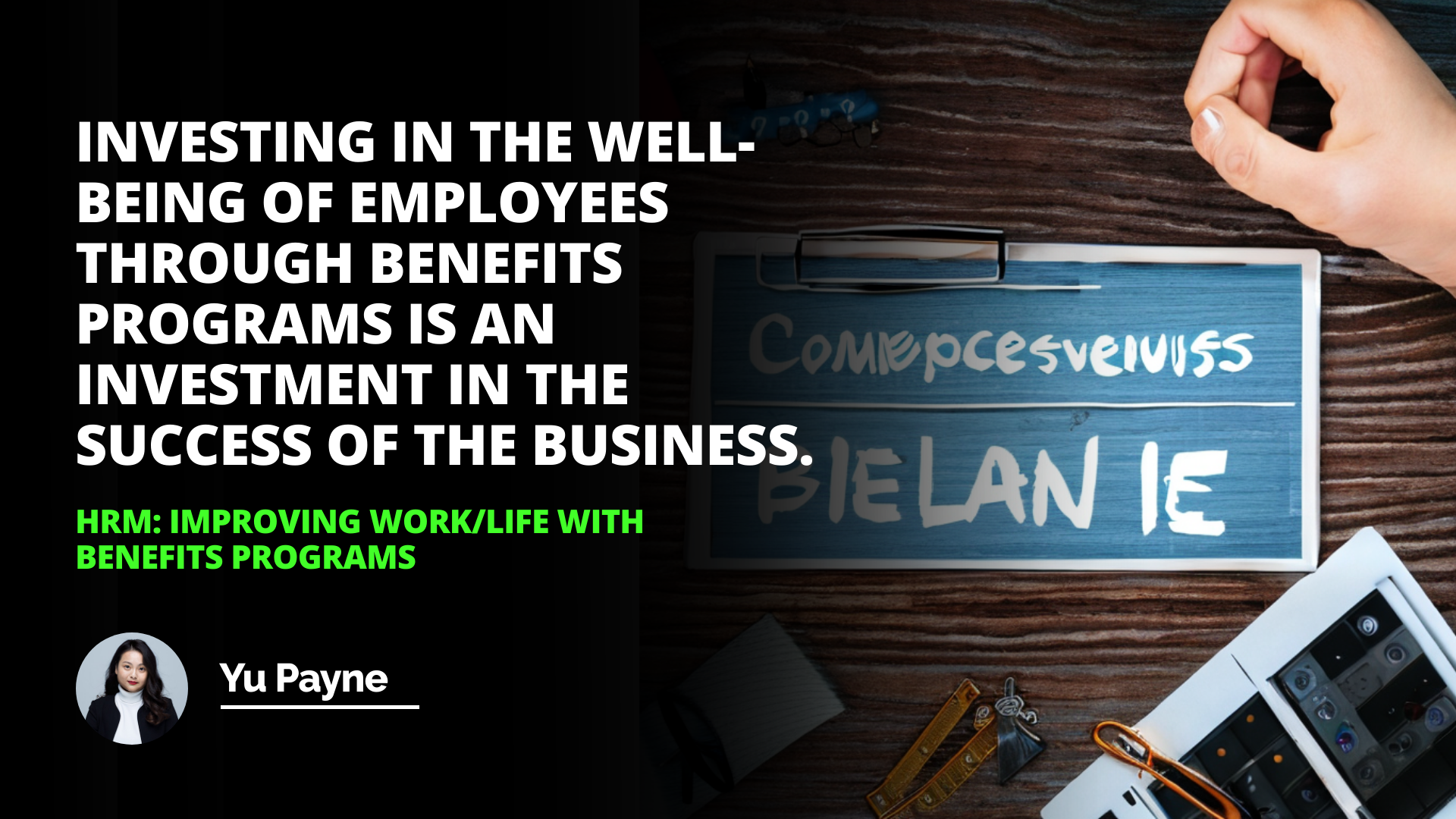
Work/Life Programs are becoming increasingly popular as organizations recognize the importance of offering flexible hours and benefits to their employees. These programs are designed to help employees achieve a better balance between their personal and professional lives and can include a variety of offerings such as on-site wellness programs, aerobics and yoga classes, and educational advancement opportunities.
Cendant Mobility Services Corp., in Danbury, Connecticut, is an example of an organization that has successfully implemented a work/life program, which has been credited with a dramatic reduction in turnover and personal and sick time use. The benefits of work/life programs are numerous and can lead to increased employee satisfaction, improved morale, and increased productivity.
Introduction
Benefits Programs Overview
Cendant Mobility Services Corp. as an Example
Benefits of Work/Life Programs
Conclusion
Introduction: Work/Life Programs are becoming increasingly popular as organizations now recognize the importance of offering employees flexible hours and more benefits. These programs, often called "work/life balance programs," are designed to help employees achieve a better balance between their personal and professional lives. Organizations can point to reduced turnover, increased motivation, and improved productivity by offering such programs.
This paper will provide an overview of work/life programs, discuss the benefits of such programs, and present Cendant Mobility Services Corp. as an example of an organization that has successfully implemented a work/life program.
Benefits Programs Overview
Work/Life Programs are designed to meet the needs of both employers and employees. These programs can include a variety of offerings, such as on-site wellness programs, aerobics and yoga classes, and educational advancement opportunities. By providing employees with these types of benefits, organizations can attract and retain talented individuals while simultaneously helping employees manage their personal and professional lives better.
The Role Of Human Resource Management İn Business Operations
How To Align Hrm Strategy And Leadership To Create Successful Employer Brand
Cendant Mobility Services Corp. as an Example
Cendant Mobility Services Corp., in Danbury, Connecticut, is one organization that has successfully implemented a work/life program. This program has been credited with a dramatic reduction in turnover, plummeting from more than 25 percent in 1999 to 9.9 percent in 2002. In addition, personal and sick time use decreased by more than 70 percent among program participants. Among its most popular offerings is an employee garden at company headquarters; the park is in such great demand that Cendant must hold a lottery for available planting space.
HR Auditing: Comprehensive Insight into Organizational Assessment
Benefits Administration: Comprehensive Insights and Best Practices
Benefits of Work/Life Programs
The benefits of work/life programs are numerous. Such programs can increase employee satisfaction, morale, and productivity for organizations. For employees, work/life programs provide them with the opportunity to manage their personal and professional lives better while providing them with various benefits, such as on-site wellness programs, educational advancement opportunities, and more.
Conclusion: Work/Life Programs are becoming increasingly popular as organizations recognize the importance of offering employees flexible hours and more benefits. Organizations that offer such programs can point to reduced turnover, increased motivation, and improved productivity.
Cendant Mobility Services Corp., in Danbury, Connecticut, is an example of an organization that has successfully implemented a work/life program, which has been credited with a dramatic reduction in turnover and personal and sick time use. The benefits of work/life programs are numerous and can lead to increased employee satisfaction, improved morale, and increased productivity.
Investing in the well-being of employees through benefits programs is an investment in the business's success.

Frequently Asked Questions
What are the benefits of implementing a work/life benefits program for employees?
Employee work/life balance has become increasingly important in today's world as employees are looking for more than just a job. Implementing a work/life benefits program can positively impact employee job satisfaction, productivity, and morale.
One of the primary benefits of implementing a work/life benefits program is that it can help increase employee job satisfaction. A work/life balance program can provide employees with access to flexible work hours, telecommuting, and other benefits that can help them better manage their work and personal lives. This can be especially helpful for employees with young children or other family obligations, as they can adjust their work hours to fit their needs. Additionally, providing benefits such as paid parental leave and on-site childcare can show employees that their employer values and respects their condition to balance work and family.
Another advantage of implementing a work/life benefits program is that it can increase productivity and morale. Employers can create an environment that encourages employees to be more engaged and productive by providing flexibility to manage their work and personal lives. This can improve employee morale, as employees feel more appreciated and valued by their employer. Additionally, providing employees with the opportunity to take time off for personal reasons can help them to return to work feeling rejuvenated and ready to tackle their tasks.
Finally, implementing a work/life benefits program can also help employers attract and retain top talent. Companies that provide a work/life balance are more likely to be perceived as desirable employers. Moreover, providing these benefits can help to demonstrate to potential employees that their employer cares about their well-being and is willing to invest in their success.
In conclusion, a work/life benefits program can benefit employers and employees. Employers can create an environment that encourages employee job satisfaction, productivity, and morale by providing access to flexible work hours, telecommuting, and other benefits. Additionally, employers can use these benefits to attract and retain top talent. Therefore, implementing a work/life balance program can be a beneficial strategy for employers who want to ensure their employees are happy and productive.
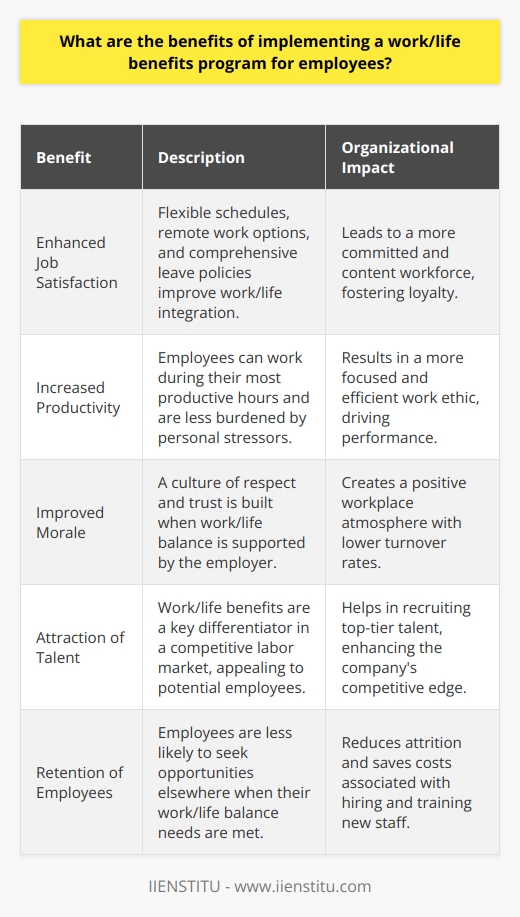
How can employers ensure that their work/life benefits program is successful?
Employers increasingly recognize the need to provide their employees with a work/life benefits program to create a positive work environment and increase employee satisfaction. Such programs can offer flexible hours, telecommuting, vacation days, and other benefits designed to help employees balance their work and personal lives. However, for a successful work/life benefits program, employers must ensure that the program is well-structured and adequately implemented.
First and foremost, employers should create clear objectives for their programs. By articulating their goals, employers can ensure that their program is tailored to their organization's and employees' specific needs. For example, the employer should consider offering flexible hours, telecommuting, and other benefits if the goal is to reduce employee stress. Additionally, employers should ensure that their program is communicated to all employees and that they clearly understand the program’s objectives.
Second, employers should establish a process for evaluating the effectiveness of their program. Employers should regularly survey employees to assess their satisfaction with the program and make any necessary adjustments. Additionally, employers should consider reviewing their program’s performance at least annually to ensure its continued success.
Third, employers should ensure that their work/life benefits program is supported by management. Managers should be trained on the program's objectives and encouraged to promote and implement them in their daily routines. Additionally, employers should ensure that their managers are held accountable for the program's success.
Finally, employers should ensure that their program is adequately resourced. Employers should ensure they have the necessary resources to implement and maintain the program. Additionally, employers should consider providing employees with the necessary support to make the most of the program’s benefits.
By following these steps, employers can ensure that their work/life benefits program is successful. By setting clear objectives, regularly evaluating the program’s success, having management support, and providing adequate resources, employers can create a positive work environment and increase employee satisfaction.
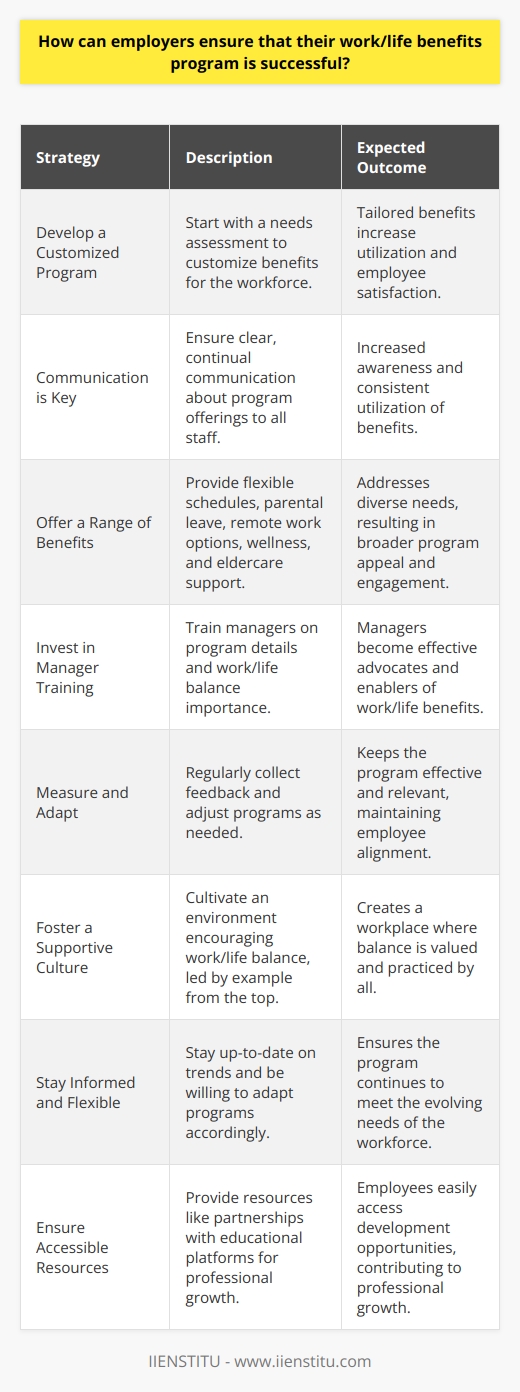
What are some examples of successful work/life benefits programs implemented by companies?
Work/life benefits programs are becoming increasingly important in today’s workplace as employers strive to help their employees better manage work and personal life demands. Companies are beginning to recognize the positive impact of work/life balance on employee satisfaction and performance. Many are implementing such programs to create a more supportive and flexible workplace. This article will discuss successful work/life benefits programs that companies have implemented.
One example of a successful work/life benefits program is flexible work arrangements. Flexible work arrangements include telecommuting, part-time work, job-sharing, and compressed work schedules. Such arrangements can help employees manage their work and personal obligations better while allowing them to remain productive and engaged. For example, Microsoft has implemented several flexible work arrangements, including telecommuting and part-time work, which have resulted in increased employee satisfaction, productivity, and commitment.
Another example of a successful work/life benefits program is paid time off. Paid time off can include vacation, sick leave, parental leave, and other forms of leave. Paid time off can help employees manage their work and personal obligations better while also allowing them to rest and recharge. For example, Google provides its employees with up to five weeks of paid vacation and up to 14 weeks of paid parental leave.
Finally, some companies have implemented wellness programs to promote work/life balance. Wellness programs can include health education and screenings, stress management, fitness classes, and more. Such programs can help employees maintain their physical and mental health while also allowing them to engage in activities that promote work/life balance. For example, Apple offers its employees a comprehensive wellness program that includes access to health education and screenings, stress management classes and fitness classes.
In conclusion, work/life balance is becoming increasingly important in today’s workplace, and many companies are implementing work/life benefits programs to create a more supportive and flexible workplace. Examples of successful work/life benefits programs include flexible work arrangements, paid time off, and wellness programs. Such programs can help employees manage their work and personal obligations better while also allowing them to rest and recharge.
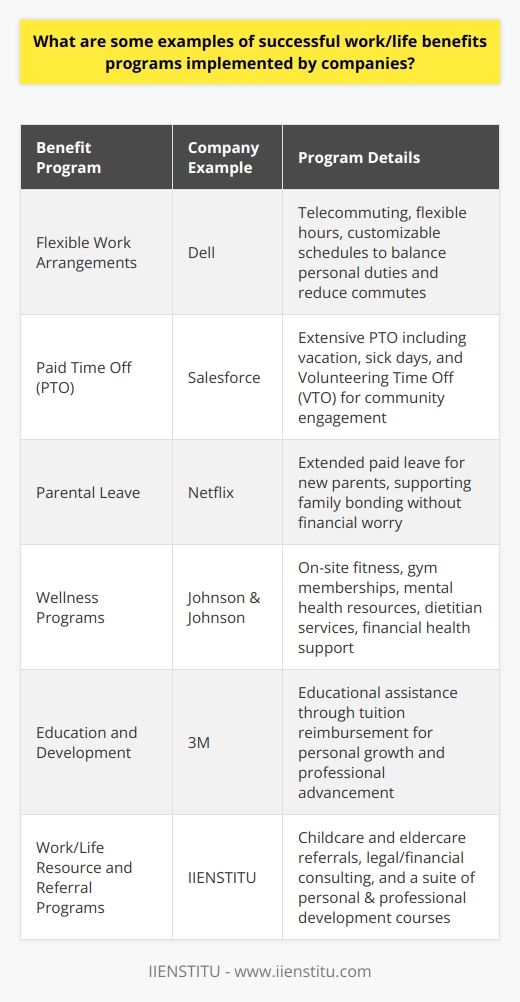
How can human resource managers help employees deal with work-life issues?
**Role of HR Managers in Addressing Work-Life Issues**
Human resource managers play a crucial role in helping employees deal with work-life issues. They can implement various strategies to create a healthy work environment that promotes work-life balance. By doing so, HR managers contribute to employee well-being and job satisfaction, ultimately leading to increased productivity and organizational success.
**Flexible Work Arrangements**
One effective approach is offering flexible work arrangements. By allowing employees to choose their working hours or telecommute, HR managers provide opportunities for individuals to fulfill personal and family responsibilities while meeting work demands. This flexibility can alleviate stress and enhance overall emotional well-being.
**Employee Assistance Programs**
Another valuable resource is employee assistance programs (EAPs) that provide support for employees dealing with various personal and work-related issues. HR managers can promote EAPs offering confidential counseling, referrals and information services to help employees cope with work-life challenges, leading to a more engaged and productive workforce.
**Work-Life Balance Policies**
In addition, HR managers can develop and enforce work-life balance policies. These policies may include limits on working hours, mandatory breaks and vacation time. By actively promoting a culture that respects employees' personal lives, HR managers contribute to a healthier work atmosphere where employees feel valued and inspired to perform at their best.
**Training and Development Programs**
To further support employees, HR managers can organize training and development programs focusing on time management, stress reduction and other work-life balance skills. This investment in employee growth not only improves work-life balance but also equips individuals with essential skills to thrive professionally and personally.
**Open Communication Channels**
Lastly, maintaining open communication channels allows HR managers to stay attuned to employees' work-life concerns. Regular check-ins, anonymous surveys or suggestion boxes can help identify areas for improvement and implement appropriate solutions. This proactive approach ensures that employees feel heard and supported, reinforcing their commitment to the organization.
In conclusion, HR managers have the power to significantly influence employees' work-life balance by implementing supportive policies and programs. Adopting a proactive and empathetic approach to addressing work-life issues not only benefits employees' overall well-being but also the organization's long-term success.
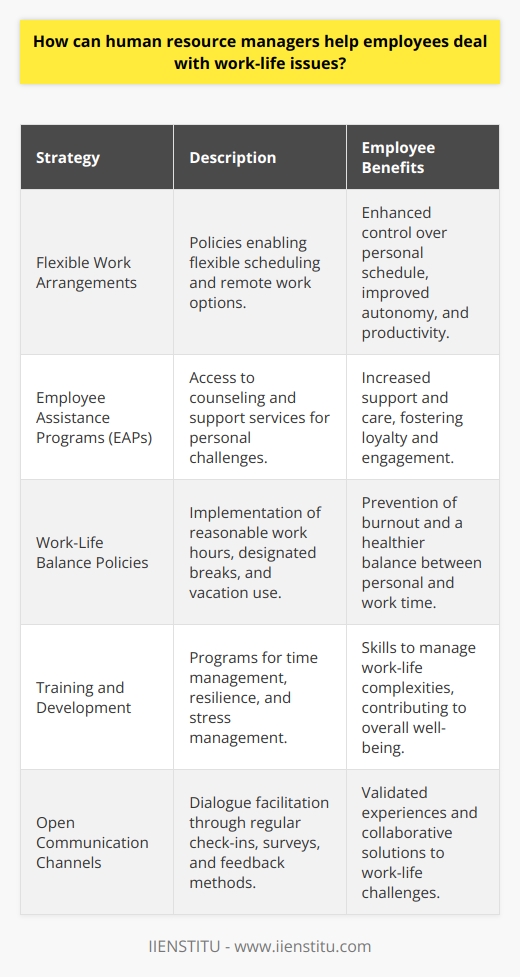
What strategies can be employed to enhance work-life balance through targeted employee benefits?
**Flexible Work Hours**
One strategy to enhance work-life balance is by implementing flexible work hours. Offering employees the option to choose their work hours, within certain limits, allows them to better manage personal and professional commitments. This flexibility can lead to reduced stress levels and improved job satisfaction.
**Remote Work Opportunities**
Another strategy is offering remote work opportunities. By enabling employees to work from home or other locations, companies can help reduce commuting time and costs, while enhancing staff's work-life balance. Remote work also nurtures increased autonomy and trust in employees, fostering a positive work environment.
**Wellness Programs**
Wellness programs can also enhance work-life balance. By promoting physical and mental health through initiatives such as gym memberships, mindfulness training, and stress management workshops, employers support their staff's well-being both in and out of the workplace. This holistic approach ultimately contributes to increased productivity and employee satisfaction.
**Paid Leave Policies**
Paid leave policies, including annual leaves, parental leaves, and sabbaticals, are essential for maintaining work-life balance. Ensuring that employees can take time off to rest, recover, or manage personal matters without facing financial penalties demonstrates a company's commitment to their well-being. This strategy fosters loyalty and retention among staff members.
**Childcare Support**
Providing childcare support is also an effective strategy for enhancing work-life balance. By offering on-site childcare facilities or subsidizing external childcare services, employers can help ease the burden on working parents, allowing them to focus on their work while confident in the knowledge that their children are well cared for. This support ultimately boosts morale and productivity.
**Employee Resource Groups**
Finally, fostering employee resource groups (ERGs) can be beneficial in promoting work-life balance. ERGs bring together individuals with common interests or characteristics, providing a supportive network and opportunities for engagement. These groups contribute to a positive and inclusive work environment, fostering a sense of belonging and enhancing work-life satisfaction.
In conclusion, a multifaceted approach that incorporates flexible work hours, remote work opportunities, wellness programs, comprehensive paid leave policies, childcare support, and employee resource groups can be employed to enhance work-life balance through targeted employee benefits. This holistic approach leads to improved employee well-being, satisfaction, and productivity while boosting company loyalty and retention.
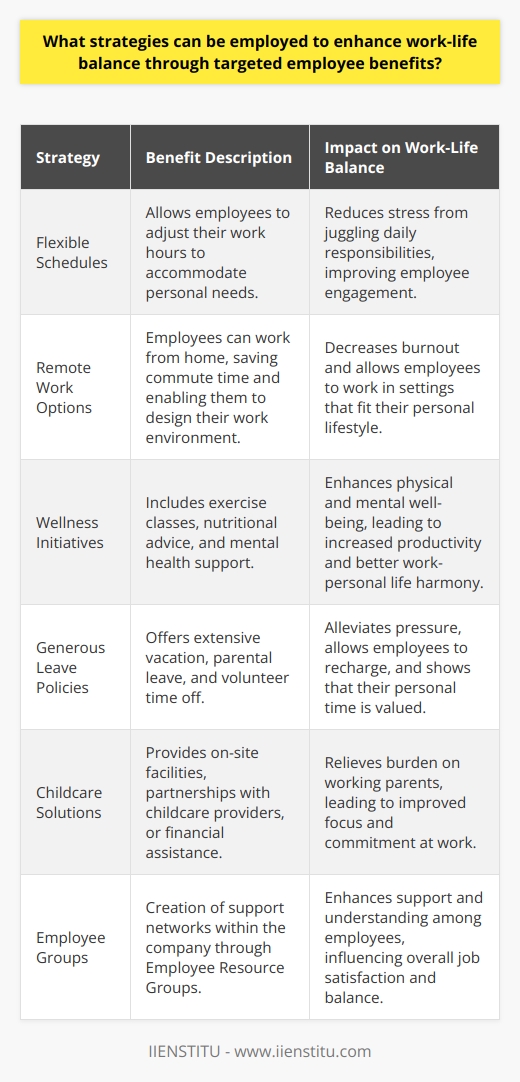
How can HRM initiatives contribute positively to employees' well-being and promote a healthy work-life balance?
**HRM Initiatives and Employee Well-being**
Human Resource Management (HRM) initiatives can significantly improve employees' well-being and promote a healthy work-life balance. By implementing supportive policies, employers create a more productive work environment and enhance overall job satisfaction.
**Flexible Work Arrangements**
Flexible work arrangements, such as remote work and flexible hours, encourage better work-life balance. Employees can manage their personal responsibilities while still meeting professional objectives, reducing stress and fostering overall well-being.
**Health and Wellness Programs**
Providing health and wellness programs at the workplace can have a positive impact on employees' physical and mental health. Activities such as exercise classes, stress-management sessions, and health screenings contribute to a healthier workforce.
**Employee Assistance Programs**
Offering Employee Assistance Programs (EAPs) provides employees with access to professional resources, such as counseling or financial planning, to address personal issues. This support enables employees to focus on work without distractions caused by unresolved personal matters.
**Regular Breaks and Time Off**
Encouraging regular breaks and sufficient time off allows employees to recharge and avoid burnout. By offering generous vacation hours and encouraging employees to use them, HR can promote a better work-life balance.
**Communication and Feedback Channels**
Establishing open communication channels and encouraging feedback empowers employees to voice their concerns and feel engaged in the workplace. Dialogues between employees and management can lead to effective solutions that foster both professional and personal well-being.
**Training and Development Opportunities**
Providing employees with training and development opportunities can boost their skillset and overall job satisfaction. Employees who feel valued, challenged, and supported are more likely to maintain a healthy work-life balance.
In conclusion, HRM initiatives that focus on supporting employee well-being and promoting healthy work-life balance can lead to a more productive, satisfied, and engaged workforce. Employers who prioritize these initiatives are likely to experience enhanced employee retention and improved company performance.
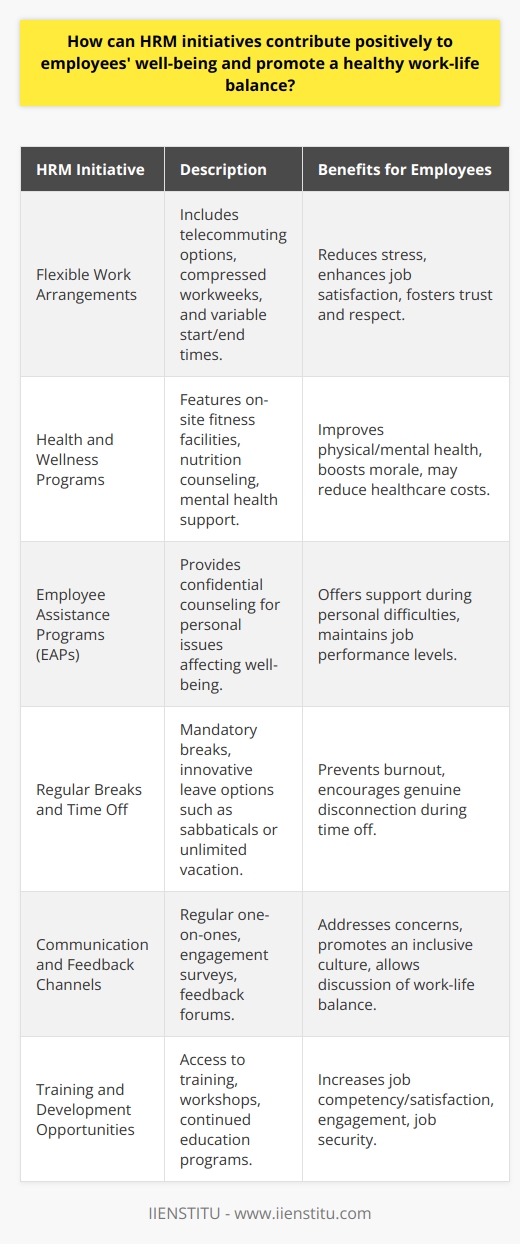
How can HRM improve work-life balance using specific management practices and strategies?
Work-Life Balance Strategies
HRM plays a pivotal role in enhancing work-life balance by implementing effective management practices and strategies. By endorsing flexible work arrangements, HR departments can help employees achieve equitable equilibrium between their professional and personal responsibilities. Telecommuting and variable work hours are prime examples of such arrangements that promote work-life balance.
Importance of Communication
Open communication channels, which address employee concerns on a regular basis, also contribute to improving work-life balance. Through maintaining an ongoing dialogue with employees, HR can identify potential roadblocks and fine-tune management practices. This approach helps build trust and mutual understanding, ultimately leading to a more harmonious work environment.
Employee Assistance Programs
HRM can further strengthen work-life balance by providing suitable Employee Assistance Programs (EAPs). EAPs offer resources, support, and counseling to employees, enabling them to cope with personal challenges while maintaining productivity at work. Examples of such programs include mental health counseling, financial guidance, and childcare assistance.
Encouraging Employee Wellness
Wellness initiatives, such as fitness and stress management programs, also underpin work-life balance. By offering on-site fitness classes or gym membership reimbursements, HR managers can promote overall well-being and increase employee satisfaction. Similarly, stress management workshops and meditation sessions, can help employees manage workplace pressures more effectively.
Recognizing and Rewarding Efforts
Recognizing and rewarding employee achievements can further contribute to improving work-life balance. HRM should ensure that these practices are implemented fairly, fostering a positive working environment, and consequently lessening stress levels. Moreover, employees are more likely to be content if they know their hard work is appreciated, which subsequently reflects their personal lives.
Training and Development Opportunities
Lastly, through the provision of tailored training and development opportunities, HRM can ensure employees thrive professionally. This growth can lead to improved work-life balance, as well-performing and fulfilled employees can effectively manage stress and workloads. Such opportunities encompass workshops, mentorships, and skill enhancement programs, which facilitate employee growth and satisfaction.
In conclusion, HRM can significantly improve work-life balance by utilizing various strategies, such as flexible work arrangements, open communication, Employee Assistance Programs, wellness initiatives, recognition schemes, and development opportunities. Through the implementation of these targeted measures, HRM can foster a more balanced, productive, and satisfied workforce.
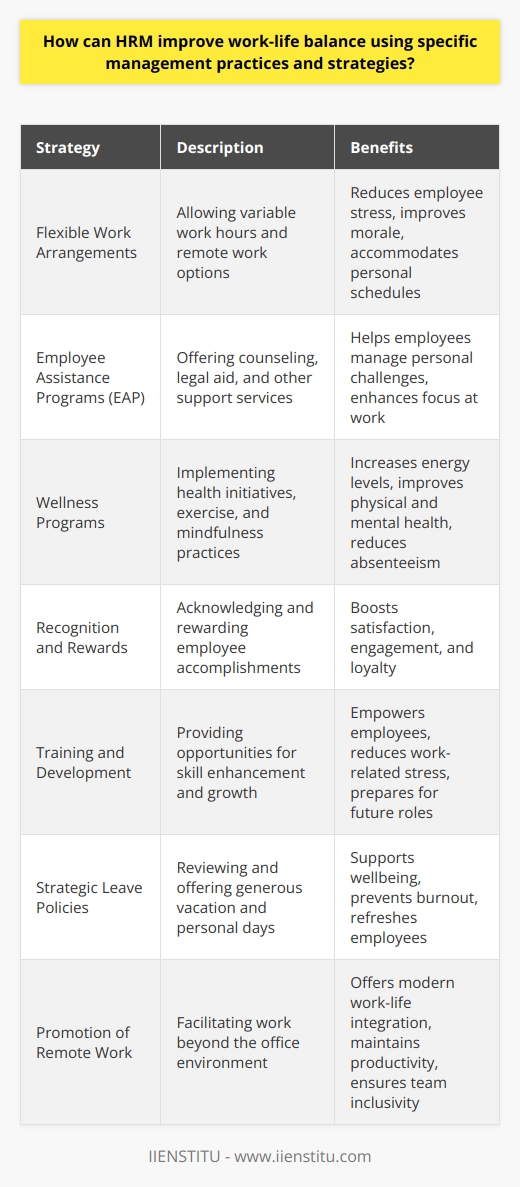
In what ways can human resource managers assist employees in addressing work-life balance concerns and challenges?
Assessing Employee Needs
Human resource managers can play a crucial role in assisting employees in addressing work-life balance concerns and challenges by initially assessing their needs. This includes conducting surveys, interviews, or focus groups to gather information from employees regarding the potential areas in need of support and improvement.
Establishing Flexible Work Policies
Based on the identified needs, HR managers can establish and implement flexible work policies to cater to employees' diverse personal and professional requirements. Such policies could include flexible working hours, remote work options, or job sharing, providing employees with more choices and control over their schedules while allowing them to reduce conflicts between work and personal life.
Offering Work-Life Balance Programs
Apart from flexible work policies, HR managers can also introduce work-life balance programs to support employees. These may include stress management workshops, financial planning seminars, or providing access to employee assistance programs in order to enhance personal well-being and, in turn, promote a healthy balance between work and life.
Promoting a Healthy Organizational Culture
HR managers should work towards fostering a healthy organizational culture that values work-life balance as a priority. This involves encouraging managers and leaders to act as role models, exhibiting balanced lifestyles while offering support and understanding towards their employees. This approach can create a positive impact on the overall work environment, making it conducive for employees to achieve work-life balance.
Looking Beyond Traditional Benefits
Finally, human resource managers can explore innovative benefits beyond traditional healthcare and retirement packages tailored to address work-life balance concerns. These unique perks may include offerings like paid parental leave, mental health support services, reimbursement for wellness expenses, or even support for childcare, significantly contributing to the overall work-life balance in the lives of employees.
In conclusion, human resource managers have the potential to effectively support employees in addressing work-life balance concerns and challenges through a multi-faceted approach of assessing needs, establishing flexible work policies, offering work-life balance programs, promoting a healthy organizational culture, and looking beyond traditional benefits. These initiatives can help create a supportive and balanced work environment, ensuring employees can achieve both personal and professional success.
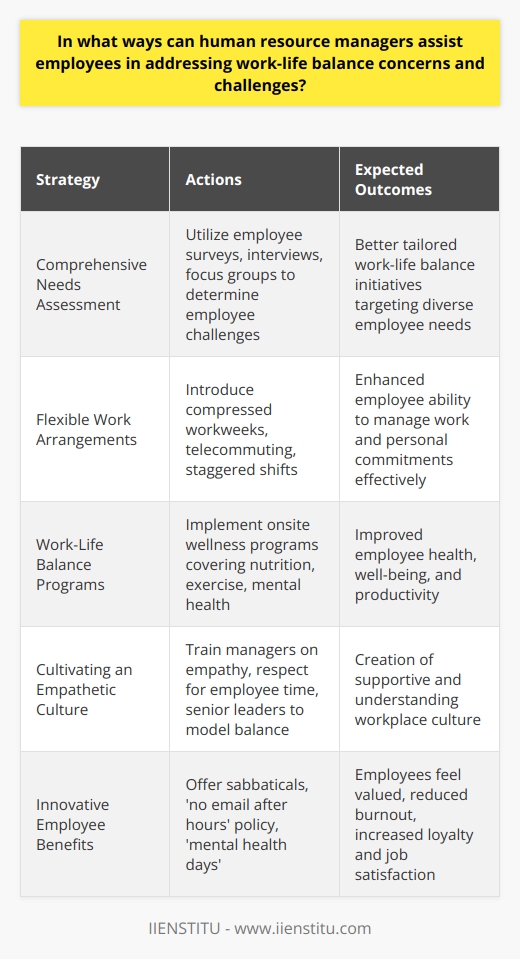
What are the essential elements of a comprehensive work-life balance program that organizations should prioritize, and how do these elements support employees' well-being?
Work-Life Balance Program Essentials
A comprehensive work-life balance program should prioritize three essential elements: flexible work arrangements, employee well-being initiatives, and support for work-life integration. These elements, when effectively implemented, can significantly contribute to employees' overall well-being, satisfaction, and productivity.
Flexible Work Arrangements
First, organizations should prioritize implementing flexible work arrangements such as telecommuting, flexible hours, and job-sharing opportunities. These options allow employees to better manage their personal and professional responsibilities by providing greater control over their work schedules. A flexible work environment acknowledges the diverse needs of employees, enabling them to achieve a healthier balance between their job and personal life, thereby reducing stress levels and enhancing well-being.
Employee Well-Being Initiatives
Second, companies should focus on employee well-being initiatives that cater to their employees' physical, mental, and emotional health. Programs including mental health support, stress management workshops, and exercise classes promote a culture of well-being within the organization. These initiatives not only demonstrate the company's commitment to addressing the various stressors employees face in their daily lives but also foster a healthier and more productive workforce.
Support for Work-Life Integration
Finally, organizations should consider providing support mechanisms for work-life integration, such as employee assistance programs (EAPs), childcare facilities, or eldercare support services. By addressing the concerns and challenges that employees experience in managing their various responsibilities, organizations can create a supportive workplace environment. These support systems help to alleviate the burden of coordinating care and allow employees to focus on their work with a sense of ease, ultimately promoting a healthier balance between work and personal life.
In conclusion, a comprehensive work-life balance program should encompass flexible work arrangements, employee well-being initiatives, and support for work-life integration. These elements, tailored to the specific needs and values of an organization, can significantly improve employees' well-being and productivity, fostering a positive workplace culture and retaining valuable talent in the long run.
